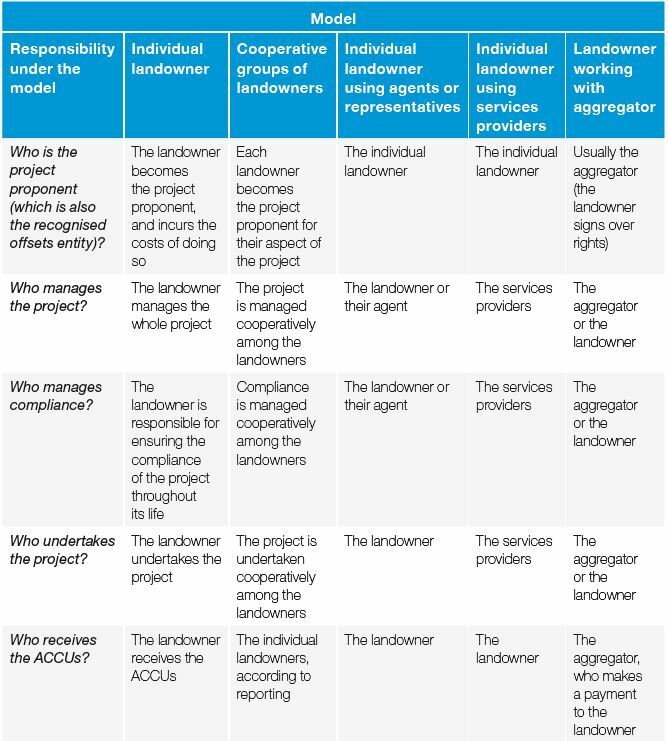There are a number of ways to structure your participation in the ERF. The alternatives involve differing extents of coordination and contracting with other businesses. The different approaches involve sharing different aspects of project operation, management and risk.
Each option has a different way of sharing the costs, benefits and responsibilities for the project. The broad options are summarised in Table 7.1 and discussed further below. In addition, Appendix C (Section C.9) sets out the legal details for contracts that may be formed under any of these arrangements.
Table 7.1: Models for participation in the ERF |
|
|
7.2.1 Individual landowner
A landowner can be the project proponent, be a recognised offsets entity, and undertake the project. They retain all responsibility for the project and receive all the ACCUs. In this case, all the costs and risks (as well as the benefits) are incurred by the individual landowner.
7.2.2 Cooperative groups of landowners
Groups of landowners can create informal cooperatives to share knowledge and reduce costs. A cooperative could be facilitated by a natural resource management organisation or a government agency. Each landowner in the cooperative needs to be a recognised offsets entity and be the project proponent responsible for the project on their land in order to receive the ACCUs.
7.2.3 Landowners using agents or representatives
The landowner may choose to use agents or representatives (probably on a fee-forservice basis) for particular aspects of managing the compliance associated with the CFI.
Agents - An agent can make or withdraw ERF applications, provide information in relation to an application or request and give notices or submissions with respect to the offsets project. The agent does not need to be the project proponent, be a recognised offsets entity or hold an account in the National Registry of Emissions Units, and would not receive the ACCUs.
Authorised representatives - An authorised representative may view the details of the registry account and initiate and approve transactions in relation to the account. They do not need to be a recognised offsets entity or hold an account in the registry and would not receive the ACCUs.
7.2.4 Landowners using service providers
The landowner can use professional service providers to undertake any part of their project, including obtaining approvals and reporting on the project, undertaking the project, or both. The landowner would generally be the project proponent and the recognised offsets entity responsible for the project and receive the ACCUs. This arrangement would be mediated through an appropriate contract and would be on a fee-for-service basis.
7.2.5 Landowners working with aggregators
Landowners may choose to use an aggregator to participate in the ERF. Some examples of aggregators are provided in Box 7.1.
The aggregator would generally be the project proponent and recognised offsets entity responsible for the project, including for the submission of project reports and audits, and receive the ACCUs.
Depending on the contract between the landowner and aggregator, the landowner or the aggregator may carry out and manage the project.
7.2.6 Which arrangement is best?
The factors that determine which of these arrangements is most suitable for a particular farming enterprise are:
-
the exact nature of the contract with the carbon aggregator.
-
the requirement for the landowner to share the risk (and consequently the returns) from the project
-
the expertise of the individual farmer and their willingness to devote their time to the requirements of the ERF project
-
the complexity of the method and the need for specialist input in operating according to that method
-
the relative cost of engaging agents and service providers
Box 7.1: Carbon aggregators - examples |
There are a number of alternative arrangements for the ownership and control of the land depending on the preferences of the developer and the landowner. In some cases, the aggregator purchases or rents land from landowners and owns the ACCUs that are earned on the land; in other cases, they manage the project on behalf of the landowner, who maintains the rights to the carbon credits.These companies operated both in the compliance markets and in voluntary carbon markets. An aggregator has the same requirements as any other participant to substantiate their legal right to undertake the project, and responsibility for the project. Several registered companies are listed here:
|
























